 The Two Micron All Sky Survey at IPAC
The Two Micron All Sky Survey at IPAC
![]()
 The Two Micron All Sky Survey at IPAC
The Two Micron All Sky Survey at IPAC
|
|
|
This is the second large incremental data release from the Two Micron All Sky Survey. This release covers over 19,600 deg2 of sky observed from both the northern 2MASS facility at Mt. Hopkins, AZ, and the southern 2MASS facility at Cerro Tololo, Chile. The release data products include 1,897,500 compressed 512×1024 pixel (1"/pixel) Atlas Images in the three survey bands (82,500 images lie at the Survey scans ends and are 512×698 pixels), and Catalogs containing positional and photometric information for over 162,213,354 million Point and 585,056 Extended sources.
Users are encouraged to first familiarize themselves with the Explanatory Supplement.
 Access the data via the Infrared Science Archive (IRSA) web interface
Access the data via the Infrared Science Archive (IRSA) web interface |
 Obtain additional general information
Obtain additional general information |
 |
 See an image gallery
of interesting and beautiful objects in the release
See an image gallery
of interesting and beautiful objects in the release |
 Order the DVD-ROM of Catalog data
Order the DVD-ROM of Catalog data |
 Email the 2MASS Help Desk for user support or more information
Email the 2MASS Help Desk for user support or more information |
 View the Explanatory Supplement
View the Explanatory Supplement |
 See the sky coverage
See the sky coverage |
 Consult frequently asked questions (FAQs)
Consult frequently asked questions (FAQs) |
 . . |
 Please take a few moments to complete our User Feedback Form.
Please take a few moments to complete our User Feedback Form.
We appreciate your opinions and comments about the data release.
Also, please include this acknowledgment in any published material that makes use of the 2MASS Second Incremental Release data products.
Additionally, we encourage you to notify us (at 2mass@ipac.caltech.edu) as soon as possible about any refereed publications or conference proceedings (even in preprint form) that make use of these Release data products.
Thank you very much.
Sky coverage of the 2MASS Second Incremental Release
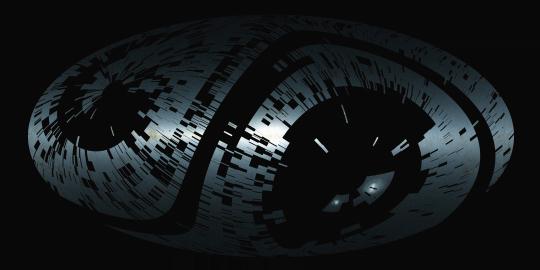 |
| (Map of the average Point Source Catalog source density in 5´ × 5´ bins in a |
| galactic aitoff projection, with a equatorial coordinate grid overlaid.) |
Sources in the Point Source Catalog (PSC) meet the following criteria:
The distribution of sources in the Second Incremental PSC with galactic latitude is
shown in Figure 1. Differential point
source counts are shown in Figure 2
(for 2° diameter, or 3.1 sq. deg., field at the north galactic pole,
l=114°, b=+35°) and
Figure 3 (same as Figure 2, except at a location near the Galactic Plane
at l=55°), where the blue line denotes J-band; green line, H-band;
and, red line, Ks-band.
At high latitude, the 2MASS PSC contains accurate detections
well below the nominal Survey completeness limits of J=15.8, H=15.1
and Ks=14.3 mag. The turnover in the source
counts in the Galactic Plane field occurs nearly 1 mag brighter,
because of the effects of confusion noise on the detection thresholds.
Additional general information about the 2MASS Second Incremental Release
 7 in at
least one band (to insure reliability and avoid flux overestimation bias at lower SNR)
7 in at
least one band (to insure reliability and avoid flux overestimation bias at lower SNR)
 <10 in at least
one band (to reject residual cosmic rays)
<10 in at least
one band (to reject residual cosmic rays)
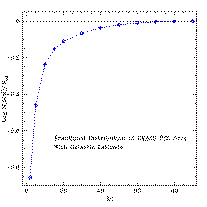
|
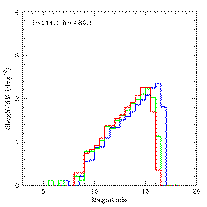
|
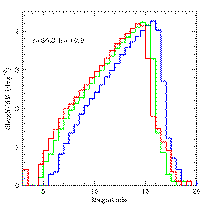 |
| Figure 1 | Figure 2 | Figure 3 |
The characteristic photometric precision of measurements of unconfused sources in the 2MASS PSC is illustrated by Figure 4 which shows the photometric repeatability for point sources in the P161-D calibration field.
Figure 5 shows the JHKs color-color diagram for the three-band-detected sources in a 2°-diameter north Galactic pole field (yellow=SNR(Ks)>40; blue=SNR(Ks)>20; black=SNR(Ks)<20); red and green lines indicate dwarf and giant tracks, respectively, from Bessell & Brett (1988, PASP, 100, 1134) and Koorneef (1983, As.Ap. 129, 84); the diagonal black line indicates the reddening vector for AV=5 mag). There is no evidence for reddening in this field, and there are very few bright (high SNR) stars. Figure 6 shows the JHKs color-color diagram for the three-band-detected sources in a 2° diameter Galactic plane field (legend same as Figure 5). There is considerable reddening of the stars in this field, plus a significant population of giant stars. Confusion in high source density regions contributes to the large scatter in the colors of the low SNR sources.
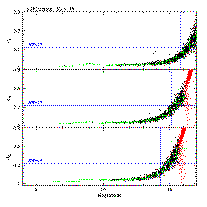
|
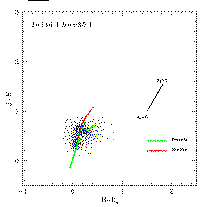
|
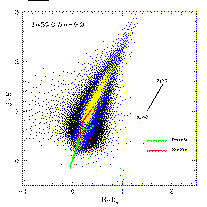 |
| Figure 4 | Figure 5 | Figure 6 |
Sources in the Extended Source Catalog (XSC) meet the following criteria:
 15.1, or,
Ks
15.1, or,
Ks  13.5 mag
13.5 mag
 7, or,
SNR(Ks)
7, or,
SNR(Ks)  7
7
Figure 7 shows the sky distribution of the XSC. Figure 8 shows the fractional distribution of 2MASS XSC sources with galactic latitude. Note that the source counts are not normalized by the areal coverage. Figure 9 shows the differential extended source counts corresponding to low stellar confusion fields, <1000 stars deg-2 brighter than Ks=14 mag. The error bars represent sqrt(n) uncertainty measures. The sources comprise a total areal coverage of ~2350 square degrees. Most of the area is free of known nearby clusters (redshift z < 0.1), but a small percentage does include the Abell 262 cluster in Perseus and the outer fringes of the Virgo Cluster. For comparison, deep but narrow-field counts from Glazebrook et al. (1994, MNRAS, 266, 65), denoted with a dotted line, and Gardner et al. (1997, ApJ, 480, L99), denoted with "+" symbols, are shown.
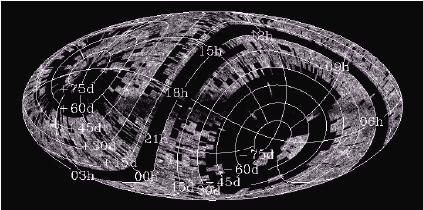
|
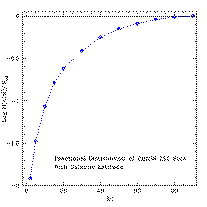
|
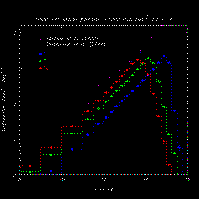 |
| Figure 7 | Figure 8 | Figure 9 |
Figure 10 is the color-color distribution
for extended sources located within low stellar confusion fields, <1000
stars deg-2 brighter than Ks=14 mag. Galaxies
are indicated by symbols coded according to the J-Ks
SNR. The solid lines denote the main sequence locus (giants diverge at large
J-H). The dashed line and triangle points denote the K-correction curve
for a spiral galaxy (no evolution), where each triangle represents 0.1 in
redshift (z). Figure 11 shows
the angular size of extended sources as a function of Ks. The top
panel shows the size distribution (in arcsec) of the semi-major axis radius
corresponding to the best-fit ellipse of the 20 mag arcsec-2
Ks-band isophote. The minimum radius corresponds to 7´´
(horizontal dashed line). The middle panel shows the size distribution of the
semi-major axis radius corresponding to the best-fit ellipse of the 21 mag
arcsec-2 J-band isophote. The bottom panel shows the semi-major
axis radius corresponding to the 3 Ks-band isophote, corresponding to roughly 18.8 mag arcsec-2
surface brightness. The minimum 3
Ks-band isophote, corresponding to roughly 18.8 mag arcsec-2
surface brightness. The minimum 3 radius is
~5´´. Note: for the 3
radius is
~5´´. Note: for the 3 distribution,
only about half of the sources are plotted.
distribution,
only about half of the sources are plotted.
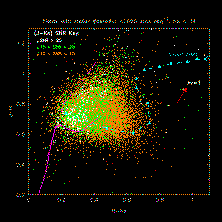
|
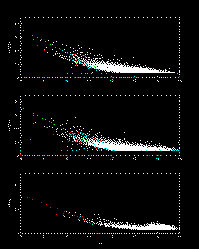 |
| Figure 10 | Figure 11 |
Please include the following in any published material that makes use of the 2MASS data products:
"This publication makes use of data products from the Two Micron All Sky Survey, which is a joint project of the University of Massachusetts and the Infrared Processing and Analysis Center/California Institute of Technology, funded by the National Aeronautics and Space Administration and the National Science Foundation."
Thank you very much.
Return to the 2MASS Home Page